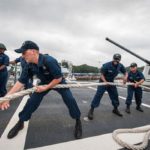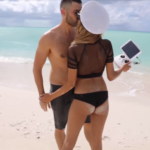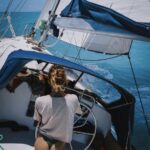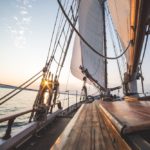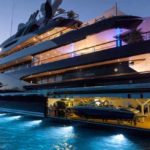This is where everyone in our realm can learn or brush up on all sailing skills.
–
Table of Contents:
- Introduction
- Vocabulary
- Progression
- Conceptual Images
–
Introduction:
- 71% of the Earth is covered by water; the oceans, etc. –and much more, if you count all the rivers, inland seas, lakes, creeks, ponds, streams, tributaries, and so on.
- “Maritime transport is the backbone of international trade and the global economy. Over 80% of the volume of international trade in goods is carried by sea, and the percentage is even higher for most developing countries.”
- Both polar holes to the hollow inner Earth are surrounded by water.
- Outer Space used to be an atmosphere airships sailed through all the time.
- Inisfree is surrounded by the challenging Southern Ocean.
It makes sense to know how to sail.
–
Vocabulary:
- Port: Facing forward, this is anything to the left of the boat. When you’re onboard, you can use this term pretty much any time you would normally say “left.”
- Starboard: Facing forward, this is anything to the right of the boat. Same deal as “port”–only the opposite.
- Bow/Stern: The bow is the front of the boat, the stern is the back. Anything near the front of the boat is said to be “forward,” and anything toward the back is “aft” or “astern.”
- Point of Sail: The boat’s direction relative to the wind. You cannot sail directly into the wind.
- Helm: Where you steer the boat. Usually this is a big wheel, but on smaller boats it can be a tiller, which is basically a long wooden stick. Either of these can be used to control the boat’s rudder.
- Helmsman: The man or woman steering the boat.
- Keel: The keel is a long, heavy fin on the bottom of the boat that sticks down into the water. It makes the boat more stable and is the reason why modern sailboats are really hard to capsize.
- Heeling: This is the term for when a sailboat leans over in the water, pushed by the wind.
- Tack: This term has two meanings, both of them important. To tack is to change direction by turning the bow of the boat through the wind. Your tack is also the course you are on relative to the wind. For example, if the wind is blowing over the port side, you are on a port tack. If it’s blowing over the starboard side, you’re on a…you guessed it…starboard tack.
- Jibe: A jibe is another way of changing direction, in which you bring the stern of the boat through the wind. Whether you choose to tack or jibe depends on what’s around you, and the direction of the wind.
- Windward: The side of the boat closest to the wind. When heeling over, this will always be the high side.
- Leeward: The side of the boat furthest from the wind. When heeling over, this will always be the low side.
- Lines: On board a boat, this is what you say instead of “ropes.”
- Mainsail: The big triangular sail which is the boat’s largest and most important sail. Running along its bottom edge, the mainsail has a thick pole called the boom.
- Jib: The next most common sail on any boat. The jib can always be found forward of the mast, and unlike the mainsail, does not have a boom.
- Rigging: Rigging is the name for the system of wire cables and ropes that both support the sails and allow them to be controlled.
–
Progression:
We first teach where to find each part of a boat and then a ship (bigger than a boat, distinct from just a boat in several ways),
then have students watch professional sailing instructors demonstrate on calm waters in one of our canals.
As the days and years go by, this is steadily expanded until the students are able to function as any part of a sailboat’s/ship’s crew, even during inclement weather and rough/high seas.
The result is a competency rivaling that of the midshipmen learning at the U.S. Naval Academy.
General:
- moving quickly to each named part/device of a boat/ship
- operating a sextant and other critical tools
- making navigation decisions based on weather within visual range
- RADAR operation
- SONAR operation
- naval flags for signaling
- Morse code via spotlights
- overboard procedure/s
- damage procedure/s
- fire procedure/s
- handling boats & ships in port
- handling boats & ships on a river
- handling boats & ships offshore (with the shore in sight)
- handling boats & ships at sea
- handling (Space-faring) (life)boats & (star)ships out in Space (just the basics; the full course-load starts in our 19th grade)
By School-year:
- Definitions
- Rafts
- Paddleboats
- Canoes and Kayaks
- Zodiacs
- Astrolabe
- Sailboats (and maybe jet-skis and fly-boards)
- Yachts
- Submarines
- Frigates
- Cruisers
- Battleships
- Exodus
- Carriers
- Spaceships
- Captaining
–
reference: wiki
–
–
video

